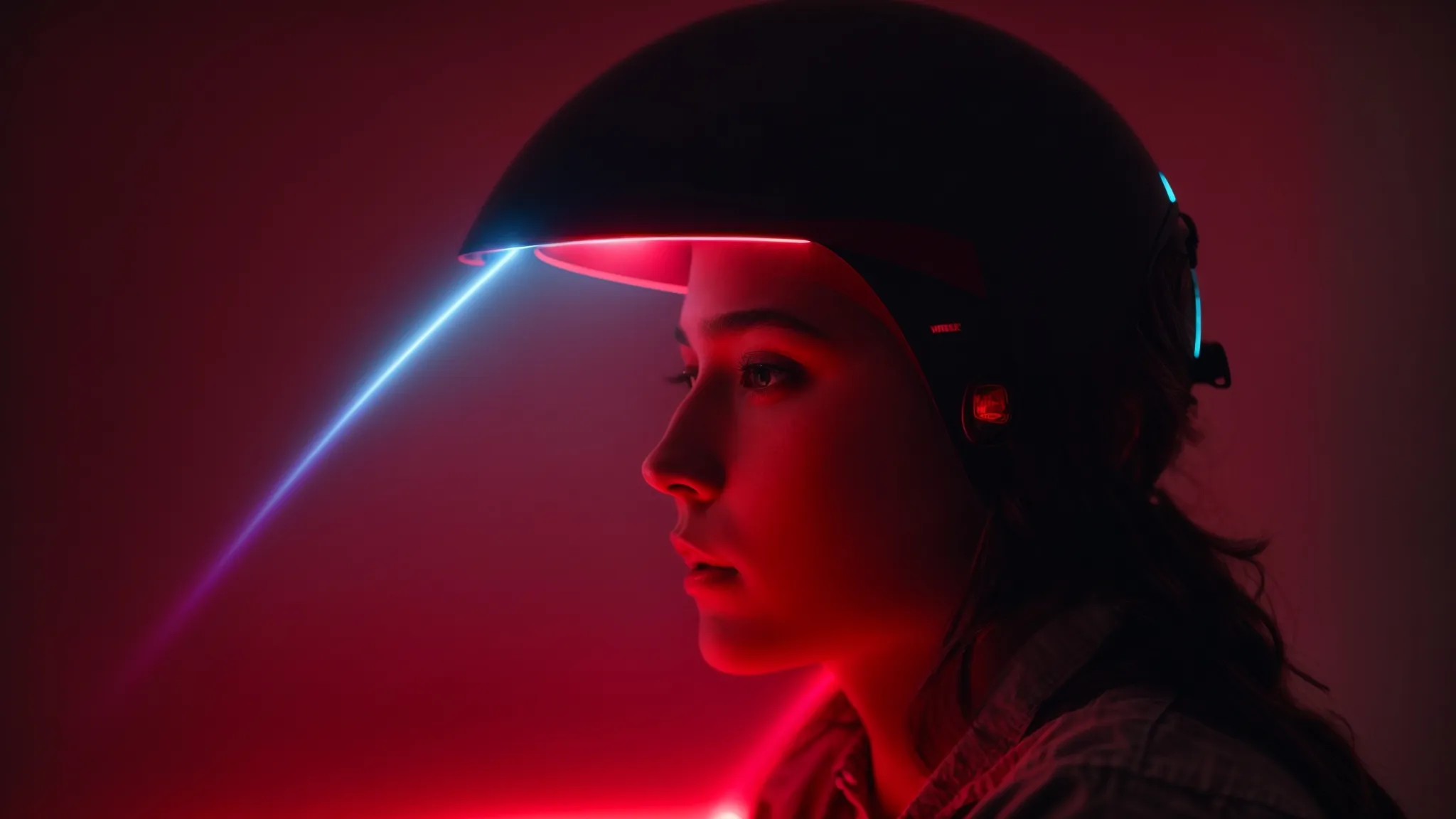Understanding the Role of Laser Therapy Caps in Fighting Dandruff
For those tirelessly battling the persistent flakes and itchiness of dandruff, the red light head cap emerges as a beacon of hope, promising a reprieve where shampoos and serums fall short.
Harnessing a blend of biotin enrichment and sophisticated technology, these caps delve directly into the issue at the root, employing infrared energy to soothe an irritated scalp and encourage healthier hair growth.
It's not merely a comfort; it's an innovative approach to an age-old problem.
This article will guide you through the transformative journey of using laser therapy caps, comparing their effectiveness to conventional dandruff treatments and outlining crucial safety measures.
Keep reading to equip yourself with the knowledge to turn the tide against dandruff effectively.
Key Takeaways
- Laser Therapy Caps Offer an Alternative Treatment for Dandruff, Targeting Scalp Symptoms at a Cellular Level
- Specific Wavelengths and Frequencies in Laser Caps Are Crucial for Treating Dandruff and Promoting Scalp Health
- Portable and Stationary Laser Therapy Caps Cater to Different Lifestyle Needs, With Both Offering Benefits for Dandruff Management
- While Effective for Dandruff, Laser Therapy Caps Necessitate Attention to Contraindications and Potential Side Effects
- Assessment of Laser Cap Design and Treatment Frequency Is Imperative to Ensure Optimal Effectiveness and Scalp Health
How Laser Therapy Caps Work Against Dandruff

Delving into the workings of laser therapy caps offers insight into a modern approach to tackling dandruff, a persistent condition for many.
These innovative caps harness laser technology, a method that has been observed to influence scalp health positively.
While traditional remedies often depend on topical treatments such as shampoos infused with vitamins or a soothing massage, the laser cap introduces a novel dimension to scalp care.
Patients now have the option to complement these routines with a helmet-like device, which bathes the scalp in therapeutic light aimed at reducing flaky skin and improving follicle vitality.
The science of laser therapy technology, its impact on scalp wellness, and its capacity to mitigate dandruff through light exposure form the pillars of this advanced treatment option.
The Science Behind Laser Therapy Technology
The scientific community has shown increasing interest in the role of genomics in conditions like dandruff, suggesting that genetics may predispose individuals to scalp issues. However, the privacy concerning genetic information requires careful consideration.
Meanwhile, laser therapy caps operate on a cellular level, where a key element is the stimulation of cytochrome c oxidase, an enzyme within the mitochondria. This action prompts increased cellular energy production, potentially leading to improved scalp health and reduction in dandruff symptoms, a claim supported by emerging evidence:
- Stimulation of cytochrome c oxidase enhances cellular metabolism and repair mechanisms.
- Increased blood flow from light therapy delivers nutrients and oxygen, further nurturing the scalp.
- Light therapy has been documented to decrease inflammation, which is often associated with dandruff.
As for the ingredient serenoa, often cited in studies for its therapeutic properties, it remains to be seen how its efficacy is influenced when combined with laser therapy, thus expanding the horizons of evidence-based scalp treatment solutions.
Understanding How Light Affects Scalp Health
The efficacy of laser therapy caps, a brand's stride against conditions beyond dandruff, extends to addressing psoriasis, an ailment marked by painful skin patches. Absorption of specific wavelengths of light by the skin can modulate hormone levels, which in turn influences inflammatory responses contributing to psoriasis. Furthermore, the strategic application of light through these devices can also encourage hair regrowth, offering a reprieve for individuals grappling with pattern hair loss, thereby showcasing the multifaceted benefits of light on scalp health.
The Process of Reducing Dandruff With Laser Treatment
The laser therapy process commences with a physician meticulously adjusting the device to target the scalp, where dandruff proliferates. The calibrated light emissions work to reduce skin flakiness and irritation, often associated with dandruff, while also promoting wound healing. This dual action not only aids in the management of existing dandruff but may also prevent further scalp issues. In addition to these benefits, the precision-driven light energy supports skin health in various ways, including mitigating stretch marks and enhancing recovery from skin damage, with ongoing studies examining its potential in reducing the risk of skin cancer.
| Aspect of Laser Therapy | Benefit |
|---|---|
| Scalp Targeting & Flakiness Reduction | Addresses the primary area affected by dandruff; diminishes visible flaking and skin irritation. |
| Wound Healing & Skin Health | Facilitates the body's natural healing processes; may improve the appearance of stretch marks and aid in skin recovery. |
| Risk Management | Research exploring the potential role of light therapy in minimizing the risk of skin cancer. |
The shift from flakes to smooth, healthy scalp is more than just wishful thinking. Embrace the science-backed transformation that laser therapy caps bring to the battle against dandruff.
Benefits of Using Laser Therapy Caps for Dandruff

Embracing the science of laser therapy caps has marked a significant shift in the management of dandruff, with remarkable improvements in scalp health becoming increasingly apparent.
This leap forward transcends the mere suppression of visible dandruff flakes; it extends to ameliorating the underlying issue of scalp inflammation, which can often manifest as rash or dermatitis.
While traditional approaches, including hair conditioner and medicated shampoos, aim to soothe the scalp and mitigate flakes, the use of laser caps elevates this process by enhancing the scalp's repair mechanisms and overall vitality.
Such innovation not only aligns with the current principles of arthritis care, which prioritize therapeutic healing, but also with the strategic direction of forward-thinking companies determined to rethink their advertising tactics by highlighting the therapeutic aspects of their products amid a competitive market.
Improvement in Scalp Health
The introduction of laser therapy caps to the market has demonstrated notable strides in scalp health, a critical component in the battle against dandruff. Unlike plastic-heavy, oil-based applications which can weigh down hair, the cap encourages robust blood flow to the scalp, akin to the benefit traditionally sought through natural remedies like tea tree oil. This advanced medical tool works to optimize the scalp's environment, thereby reducing the reliance on topical medicine and fostering a terrain where hair can thrive.
Reduction in Dandruff Flakes
Laser therapy caps, recognized by the Food and Drug Administration, present a promising adjunct in the hair care arsenal, particularly for those battling alopecia areata. By concentrating light on the scalp, even extending to the often-neglected forehead area, these caps demonstrate a marked reduction in dandruff flakes, offering a respite for those afflicted. Considerable research comparing the efficacy of these caps against a placebo further underscores their potential in mitigating this common scalp concern.
- Endorsed by the Food and Drug Administration for scalp treatments.
- Exhibit potency in decreasing dandruff flakes, especially useful for individuals with alopecia areata.
- Scientific studies, including placebo-controlled trials, confirm the efficacy in regular hair care routines.
Increase in Overall Hair and Scalp Vitality
The advancement of laser therapy caps has been a boon for individuals with dandruff challenges, transcending gender and marketing labels to focus on efficacy. These devices, equipped with lasers as the active ingredient, move beyond the scope of laser hair removal; they encourage a healthier scalp, nurturing the bed from which hair springs. Consistently using these caps can result in a noticeable boost in hair vitality, resonating through each strand.
| Aspect of Treatment | Outcome for Hair and Scalp |
|---|---|
| Laser Therapy Caps | Improved vitality and health of hair and scalp, regardless of gender. |
| Active Ingredient | Lasers contribute to scalp health and are distinct from hair removal technology. |
| Marketing Claims | Focus on effectiveness transcends usual marketing, promoting tangible benefits. |
Understanding the advantages of laser therapy caps sets the stage for the next vital piece of the puzzle: choosing the right type. Each cap comes with its unique set of features designed specifically for tackling dandruff effectively.
Types of Laser Therapy Caps for Dandruff Treatment

Laser therapy caps have emerged as a notable addition to the arsenal against dandruff, where medication and traditional treatments have recorded varied statistics in efficacy.
These caps, designed to integrate into an individual's lifestyle with minimal disruption, come in a spectrum that differentiates between wavelengths, each tailored to a specific action on the scalp.
The discussion of whether portable devices offer the same level of convenience and stress reduction compared to their stationary counterparts is ongoing, as is evaluating designs that influence clinical trial outcomes.
Furthermore, the price of these devices is a crucial factor for many, necessitating a deeper look into cost-effectiveness and long-term benefits.
Factoring these elements becomes vital in comprehending how laser therapy caps can enhance dandruff treatment regimens effectively.
Differentiating Between Laser Wavelengths
Laser therapy caps offer a nuanced approach to dandruff management that capitalizes on varying laser wavelengths to target the disease at its root. While lower wavelengths are praised for their ability to stimulate adenosine triphosphate production, vital for cellular health and scalp rejuvenation, higher wavelengths penetrate deeper, often deployed in areas such as plastic surgery for their notable proficiency in healing and tissue repair. As these devices become integrated with mobile app technology for personalized care, users can more effectively track and address scalp health in conjunction with their broader wellbeing goals.
Portable Versus Stationary Caps
When assessing the efficacy of light therapy for dandruff, the debate often extends to the distinctions between portable and stationary laser therapy caps. Portable models offer the convenience of mobility, allowing users to continue with their daily routines while undergoing treatment, potentially leading to higher compliance rates. Conversely, stationary units often feature more robust systems with advanced diode technology that can provide a more intensive session, though they require users to allocate specific time for their use.
- Portable laser therapy caps afford users the freedom to incorporate treatment seamlessly into their day.
- Stationary caps offer a potent concentration of light, driven by sophisticated laser systems, for targeted therapy sessions.
- The choice between portable and stationary units may impact overall treatment outcomes based on user lifestyle and commitment.
Both categories are designed to optimize the absorption of specific light wavelengths by the scalp, impacting cellular functions like adenosine triphosphate (ATP) production, essential for energy transfer within follicles. While melanin in the hair plays a role in the absorption of light energy, laser cap devices cater to varying needs, ensuring that regardless of hair type, individuals can find a treatment plan that bolsters scalp health and addresses dandruff effectively.
Evaluating Cap Designs for Effective Treatment
In the realm of dermatology, evaluating the efficacy of different cap designs requires scrutiny over their capacity to treat dandruff without complicating other conditions like scars from surgery. Laser therapy caps vary not only in wavelengths but also in frequency and intensity; thus, they must be designed to maximize the absorption of therapeutic light while minimizing the conversion of testosterone to dihydrotestosterone, a culprit behind various scalp afflictions. The objective is to ensure these caps provide comprehensive care that accommodates a broad range of dermatological needs.
| Design Feature | Effectiveness | Scope of Treatment |
|---|---|---|
| Therapeutic Light Absorption | Maximizes treatment potential for dandruff | Supports overall scalp health, prevents exacerbation of skin conditions |
| Frequency and Intensity Control | Enables customization to patient's needs | Addresses specifics of dermatological conditions, including surgery scars |
| Dihydrotestosterone Minimization | Reduces risk of conditions linked to this androgen | Extends treatment efficacy to hair loss prevention |
Now that the various laser therapy caps are on your radar, let's walk through the process of using one to achieve a healthier scalp. Gear up for the steps that will guide you towards relief from the persistent annoyance of dandruff.
Step-by-Step Guide to Using Laser Therapy Caps

Embarking on the journey of laser therapy cap treatment requires a keen understanding of scalp preparation, adherence to optimal usage frequencies, and diligent maintenance to ensure the best outcome in the fight against dandruff.
Facility with these therapies can not only address the irritating flakes associated with this condition but also serve as a boon for related skin issues, such as acne.
Before beginning treatment, preparing the scalp is of utmost importance, as this lays the foundation for an effective laser session.
Engaging in a routine that enhances blood flow, possibly increasing the bioavailability of nitric oxide and thus expanding the benefits of the therapy, is essential.
Frequencies of usage play a pivotal role; determining the right balance is critical to harnessing the full potential of the light therapy.
Equally essential is the aftercare routine, which sustains the health of the skin and maintains the gains achieved from the treatment, establishing laser therapy caps as a cornerstone in managing dermatological health.
Preparing Your Scalp for Treatment
Ensuring the scalp is primed and ready to receive the benefits of laser therapy is a critical step towards the successful management of dandruff. Before initiating the treatment, individuals must cleanse their scalp to remove any build-up that may impede the penetration of light, paying particular attention if hair coloring has been applied, which can act as a barrier. Additionally, checking the scalp for any signs of irritation or itch is imperative, as laser therapy can exacerbate certain conditions; those who have undergone hair transplantation need to ensure that the treated area is fully healed. A healthy scalp is one that’s well-oxygenated, a state that supports the action of laser therapy; hence, proper scalp hygiene and care are all rights reserved for the effectiveness of the treatment.
| Preparation Step | Purpose | Bonus Tip |
|---|---|---|
| Cleansing | Removes product build-up to enhance light penetration | Use a gentle, clarifying shampoo if hair coloring is present |
| Inspection | Ensures no irritation or itch that may worsen with treatment | Consult a specialist if recently undergone hair transplantation |
| Oxygenating | Maximizes scalp health for optimal laser therapy efficacy | Massaging the scalp can increase blood and oxygen flow |
Optimal Usage Frequencies for Best Results
To optimize the efficacy of laser therapy caps in dandruff treatment, understanding the role of usage frequency is imperative. The pioneering research by Endre Mester, often considered the father of red light therapy, has laid the groundwork for applying specific nanometre ranges to target stem cell activity within the hair follicles. Adhering to a scientifically-backed schedule, often available within the accompanying device literature, ensures that cells receive the correct dosage of light, maximizing the potential for scalp health improvement and dandruff reduction.
Maintenance Routines Post-Treatment
Following each laser therapy session, maintaining the health of the scalp is critical to sustaining the treatment's benefits. To aid in the recovery of any potential mild wounds incurred by the light exposure, patients should keep the treated area clean and avoid any drugs or substances that may induce sensitivity, such as certain pigments found in hair care products. Should a headache arise post-treatment, a warm cup of tea can be soothing, while ensuring that any discomfort does not escalate is of paramount importance, indicating a body's response to the healing process.
Embracing innovation, individuals seek more than temporary relief for scalp health. Let's examine how laser therapy caps stack up against tried-and-true dandruff treatments.
Comparing Laser Therapy Caps With Traditional Dandruff Remedies

In the continuous quest for effective dandruff solutions, laser therapy caps emerge as an innovative alternative, challenging the traditional reliance on shampoos and oils.
Clinics and hair care professionals are beginning to scrutinize these devices for their ability to not only alleviate symptoms of scalp flakiness but also prevent hair loss associated with chronic scalp conditions.
This comparison delves into the efficiency of laser caps in relation to standard remedies, examining their potential to offer sustained benefits rather than the temporary reprieve typically associated with topical applications.
In analyzing their suitability, it's essential to consider the diverse range of hair and scalp types, acknowledging the role of protein structures within the hair and the impact of heat on scalp health.
Efficiency Comparison With Shampoos and Oils
When juxtaposed with traditional shampoos and oils, laser therapy caps offer a distinct mechanism of action that operates on a cellular level rather than merely addressing surface-level symptoms. While shampoos may cleanse and oils can act as a stimulant for scalp health, laser therapy targets the density and quality of scalp tissue through photobiomodulation, which can be particularly beneficial during stages like menopause, where changes in hair quality are common. The exchange of information between patient and clinician regarding these treatments is crucial to understanding their relative effectiveness.
| Treatment | Mechanism of Action | Target | User Consideration |
|---|---|---|---|
| Shampoos | Cleansing surfactants | Scalp Surface | Menopause-related scalp changes |
| Oils | Stimulant for blood flow | Scalp and Hair Density | General scalp health |
| Laser Therapy Caps | Photobiomodulation | Cellular Scalp Tissue | Long-term scalp vitality |
Analyzing Long-Term Benefits Over Short-Term Solutions
Current research indicates that laser therapy caps may offer substantial long-term benefits over traditional dandruff solutions due to their ability to modulate inflammation and promote cell growth. By stimulating growth factor production within the scalp, these devices foster a healthier environment for sustained scalp health. Furthermore, when utilized as combination therapy alongside other dandruff treatments, laser caps have the potential to provide a synergistic effect, enhancing overall efficacy and extending the period of relief from symptoms.
Suitability for Various Hair and Scalp Types
Determining the appropriateness of laser therapy caps for various hair and scalp types hinges on the understanding that these devices must interact with diverse cellular structures and suit differing individual needs. Sensitivities can arise, especially when considering a history of skin cancer, as laser treatments may not be advisable for all skin types. Furthermore, the focus of tissue engineering in creating biomimetic materials, such as therapeutic foam scaffolds that emulate natural cellular environments, illustrates the precise tailoring required for laser therapies to be effective while ensuring adherence to a rigorous privacy policy pertaining to patient health data and treatment specificity.
| Treatment Consideration | Relevance to Hair and Scalp Type | Implication for Use |
|---|---|---|
| Cellular Structure Interaction | Must be adaptable to various hair densities and scalp conditions | Personalized settings to accommodate individual sensitivities |
| Skin Cancer History | Requires careful evaluation before proceeding with light-based treatments | Potential exclusion from therapy or modified light protocols |
| Tissue Engineering Advances | Informs the development of complementary therapeutic materials | Integration of advanced materials for enhanced treatment outcomes |
Moving from herbal concoctions and shampoos to advanced therapeutic devices marks a significant leap. Let's now proceed with caution and examine the safety measures to keep in mind before introducing laser therapy caps into your routine.
Safety Precautions and Considerations Before Using Laser Caps

As the United States has seen a surge in the popularity of laser therapy caps for combatting dandruff, it is imperative for patients to be cognizant of the potential side effects associated with such treatments.
While these caps promise a novel intervention, targeting the tissue beneath the crown with rejuvenating laser light, they are not without their precautions.
For instance, medications like finasteride—used in hair loss prevention—may interact with laser treatment, hence understanding contraindications becomes essential.
It's crucial for any individual considering this technology to acquire a laser therapy cap that not only adheres to stringent safety standards but also aligns with their unique health profile.
By incorporating these measures, one can ensure a safe and efficacious enhancement to their hair and scalp care regimen.
Recognizing Potential Side Effects
As the adoption of laser therapy caps in health care settings increases, recognition of potential side effects is essential. While these devices offer a promising solution to dandruff by utilizing focused energy, sensitivity reactions to the light treatment can occur, manifesting as scalp redness or temporary discomfort. Individuals are urged to communicate any concerns or reactions post-treatment via email to their dermatologist, or seek advice on using complementary cosmetics or a gentle comb to manage any tender areas.
| Side Effect | Preventive Action | Post-Treatment Care |
|---|---|---|
| Scalp Redness | Use recommended device settings; Avoid overuse | Mild, soothing scalp products; avoid harsh chemicals |
| Discomfort | Start with lower energy levels; Gradually increase | Use a wide tooth comb; apply a calming serum if necessary |
| Hyper sensitivity | Patch test with lower intensity; Consult healthcare provider | Refrain from using irritating cosmetics; inform healthcare provider via email |
Understanding Contraindications for Laser Therapy
Before integrating laser therapy caps into their dandruff management regimen, individuals must acknowledge certain contraindications to ensure the treatment aligns with their physiological processes, such as metabolism and natural skin changes due to ageing. Patients should consult with a healthcare provider to understand the implications of light therapy on the oxidizing processes within skin cells, as imbalances could lead to adverse side effects requiring medical attention. Furthermore, it is the duty of patients and providers alike to respect and adhere to copyright laws associated with the specific technology and treatment protocols of laser therapy caps.
Tips for Selecting a Safe and Effective Laser Therapy Cap
Choosing a safe and effective laser therapy cap necessitates paying close attention to the wavelength specifications, ensuring that the device operates within the range that is therapeutic for scalp and hair conditions rather than wavelengths more suitable for wrinkle reduction or hair removal. It's imperative to opt for a cap that is FDA-cleared, bearing in mind that safety certifications are a testament to the device's adherence to established safety guidelines and its efficacy in treating scalp conditions like dandruff without causing adverse effects.
Conclusion
Laser therapy caps represent a transformative approach to managing dandruff, offering a cellular level treatment alternative to traditional remedies.
Their targeted use of specific wavelengths of light address the root of the condition by harnessing the power of photobiomodulation to stimulate scalp health.
With the capacity to not only reduce visible scalp flakiness but also promote long-term hair vitality, these caps are emerging as a pivotal tool in comprehensive scalp care.
It is imperative for individuals seeking effective dandruff solutions to consider laser therapy caps as a sophisticated and scientifically supported option in their hair care regimen.








